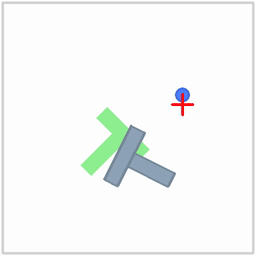A gymnasium environment PushT.
Install the project with dev dependencies:
poetry install --all-extras# example.py
import gymnasium as gym
import gym_pusht
env = gym.make("gym_pusht/PushT-v0", render_mode="human")
observation, info = env.reset()
for _ in range(1000):
action = env.action_space.sample()
observation, reward, terminated, truncated, info = env.step(action)
image = env.render()
if terminated or truncated:
observation, info = env.reset()
env.close()PushT environment.
The goal of the agent is to push the block to the goal zone. The agent is a circle and the block is a tee shape.
The action space is continuous and consists of two values: [x, y]. The values are in the range [0, 512] and represent the target position of the agent.
If obs_type is set to state, the observation space is a 5-dimensional vector representing the state of the
environment: [agent_x, agent_y, block_x, block_y, block_angle]. The values are in the range [0, 512] for the agent
and block positions and [0, 2*pi] for the block angle.
If obs_type is set to environment_state_agent_pos the observation space is a dictionary with:
- environment_state: 16-dimensional vector representing the keypoint locations of the T (in [x0, y0, x1, y1, ...]
format). The values are in the range [0, 512].
- agent_pos: A 2-dimensional vector representing the position of the robot end-effector.
If obs_type is set to pixels, the observation space is a 96x96 RGB image of the environment.
The reward is the coverage of the block in the goal zone. The reward is 1.0 if the block is fully in the goal zone.
The environment is considered solved if the block is at least 95% in the goal zone.
The agent starts at a random position and the block starts at a random position and angle.
The episode terminates when the block is at least 95% in the goal zone.
>>> import gymnasium as gym
>>> import gym_pusht
>>> env = gym.make("gym_pusht/PushT-v0", obs_type="state", render_mode="rgb_array")
>>> env
<TimeLimit<OrderEnforcing<PassiveEnvChecker<PushTEnv<gym_pusht/PushT-v0>>>>>-
obs_type: (str) The observation type. Can be eitherstate,environment_state_agent_pos,pixelsorpixels_agent_pos. Default isstate. -
block_cog: (tuple) The center of gravity of the block if different from the center of mass. Default isNone. -
damping: (float) The damping factor of the environment if different from 0. Default isNone. -
render_mode: (str) The rendering mode. Can be eitherhumanorrgb_array. Default isrgb_array. -
observation_width: (int) The width of the observed image. Default is96. -
observation_height: (int) The height of the observed image. Default is96. -
visualization_width: (int) The width of the visualized image. Default is680. -
visualization_height: (int) The height of the visualized image. Default is680.
Passing the option options["reset_to_state"] will reset the environment to a specific state.
Warning
For legacy compatibility, the inner functioning has been preserved, and the state set is not the same as the the one passed in the argument.
>>> import gymnasium as gym
>>> import gym_pusht
>>> env = gym.make("gym_pusht/PushT-v0")
>>> state, _ = env.reset(options={"reset_to_state": [0.0, 10.0, 20.0, 30.0, 1.0]})
>>> state
array([ 0. , 10. , 57.866196, 50.686398, 1. ],
dtype=float32)- v0: Original version
- TODO:
Instead of using pip directly, we use poetry for development purposes to easily track our dependencies.
If you don't have it already, follow the instructions to install it.
Install the project with dev dependencies:
poetry install --all-extras# install pre-commit hooks
pre-commit install
# apply style and linter checks on staged files
pre-commitgym-pusht is adapted from Diffusion Policy
